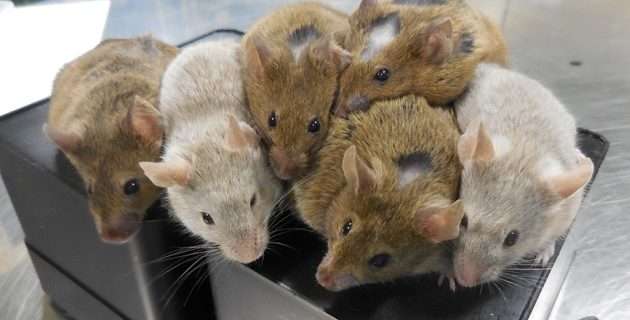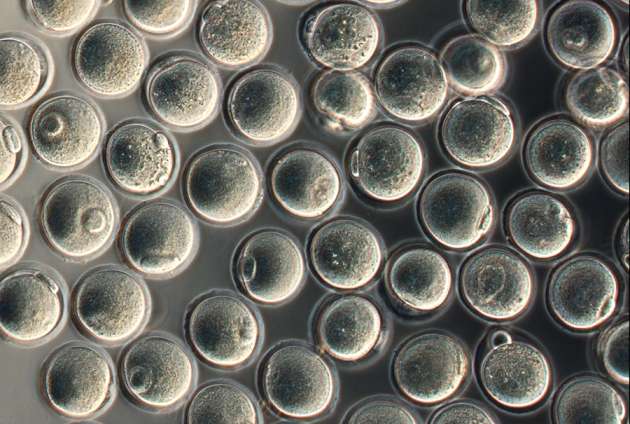Toward lab-grown designer babies

It gives new meaning to the vulgarity "a piece of tail." The latest way of divorcing baby-making from the old-fashioned method not only involves no sexual relations, it doesn't even involve eggs and sperm. At least at first.
Japanese scientists last year coaxed skin cells from mouse tails into becoming eggs. They added sperm and went on to create baby mice. Baby mice that are capable of growing up and, coming full circle, can produce their own baby mice the old-fashioned way. David Cyranoski described the painstaking complex process at Nature News. He notes, because eggs are only half the story, that Chinese scientists have reported making rudimentary mouse sperm in a dish.
IVF, meet IVG, in vitro gametogenesis. There are predictions that it will soon be usable not just in mice, but in people.
What would be the point? Well, scientists could make an egg out of skin cells from women who can't produce viable eggs–or who have other fertility problems, or who don't want to go through the difficult process of surgical removal of their eggs for IVF. Or men with fertility problems involving their sperm. Two women could make a child that was truly theirs, with eggs from one and sperm made from skin cells of the other. Or two men, vice-versa.
These uses could be justified as simply expansions of the usual process of becoming parents. But there are other, more fraught possibilities. For example, the process could create unlimited numbers of embryos for research, Ronald Bailey points out at Reason. To which there would surely be loud objections.
What about becoming a single parent deliberately, making something almost like a clone of yourself, using a gamete of your own and a gamete of the other sex fabricated from your skin cells? What about making gametes from the skin cells of celebrities–skin cells salvaged, perhaps, from a hotel bed?
What about the true creation of designer babies? Ethicist/lawyer Hank Greely speculated on that possibility in his book The End of Sex. At Stanford Lawyer he discussed what he calls "Easy PGD" with Greta Lorge. (PGD = prenatal genetic diagnosis, already in use with IVF to eliminate embryos with specific genetic defects.)
In a couple of decades, Greely predicts, it will be possible to examine and select an embryo not just for a particular genetic disease but also for other traits, ranging from hair color to musical ability to potential temperament.

Greely concedes that Easy PGD will be mostly available in rich countries, but he also thinks it will be widely available in those countries because it will be free. Preventing the birth of people with genes that increase their risk of serious (and expensive) disease will save health care systems so much money that Easy PGD will be convincingly cost-effective.
That will be a powerful incentive to encourage prospective parents to further decouple procreation from sexual intercourse, and make it easy for them to drop off their skin cells at a lab. The lab will then generate a big supply of embryos containing the couple's genes, embryos that can be examined for desirable characteristics as well as disease genes. The winner of this elimination contest will, presumably, be selected for implantation.
And that's not all the news about the creation of life–last year, genome engineers got together under the name of Human Genome Project-Write to blue-sky ideas about synthesizing new kinds of genomes (and to start raising money.) Originally they tried to keep the meeting secret for reasons outlined in a post here at On Science Blogs.
They have just met again, vowing transparency this time, still enthusing about ways to create genomes from scratch, and still looking for $100 million to do it. The emphasis on human genomes in the name has, wisely, been dropped. The undertaking is now called just Genome Project-Write (GP-write), although human genomes will still be part of the portfolio.
Even without designer babies, the ideas can be pretty dazzling. One oft-cited example: the airport security line transformed into a refreshing stroll through a botanical garden where the plants are engineered to detect bombs. Another possibility, also discussed at last year's meeting, is a human cell immune to all known viruses.
And maybe a synthetic human genome within 10 years? Researchers are also working on engineering human gut microbes to reduce risks of obesity and chronic stress, Sharon Begley reported at STAT. That work is funded by the Pentagon's Defense Advanced Research Projects Agency. DARPA is also underwriting a project to make human cells that can produce the nine essential amino acids we now must get from food because we cannot make them, according to Ryan Cross at ScienceInsider.
How to do these things is, of course, the big hurdle. For the moment projects will have to rely on gene-editing techniques like CRISPR because it's not currently possible to synthesize long DNA strands, according to John Min, who works in George Church's Harvard Lab. He told Ariel Conn at the Huffington Post that, after snipping DNA in an existing cell, the plan is to use synthetic DNA to replace excised DNA or even add new functions to the cell.
Bioethics and bioethicists were a significant presence of this year's GP-write meeting, part of the commitment to transparency. Ed Yong has asked an interesting question about that. Does genome creation generate unique ethical issues, something completely different "from those that have already been endlessly discussed for CRISPR, stem cells, cloning, and other biotech"?
No one, he wrote at The Atlantic, offered a clear answer.
Provided by Public Library of Science
This story is republished courtesy of PLOS Blogs: blogs.plos.org.




















